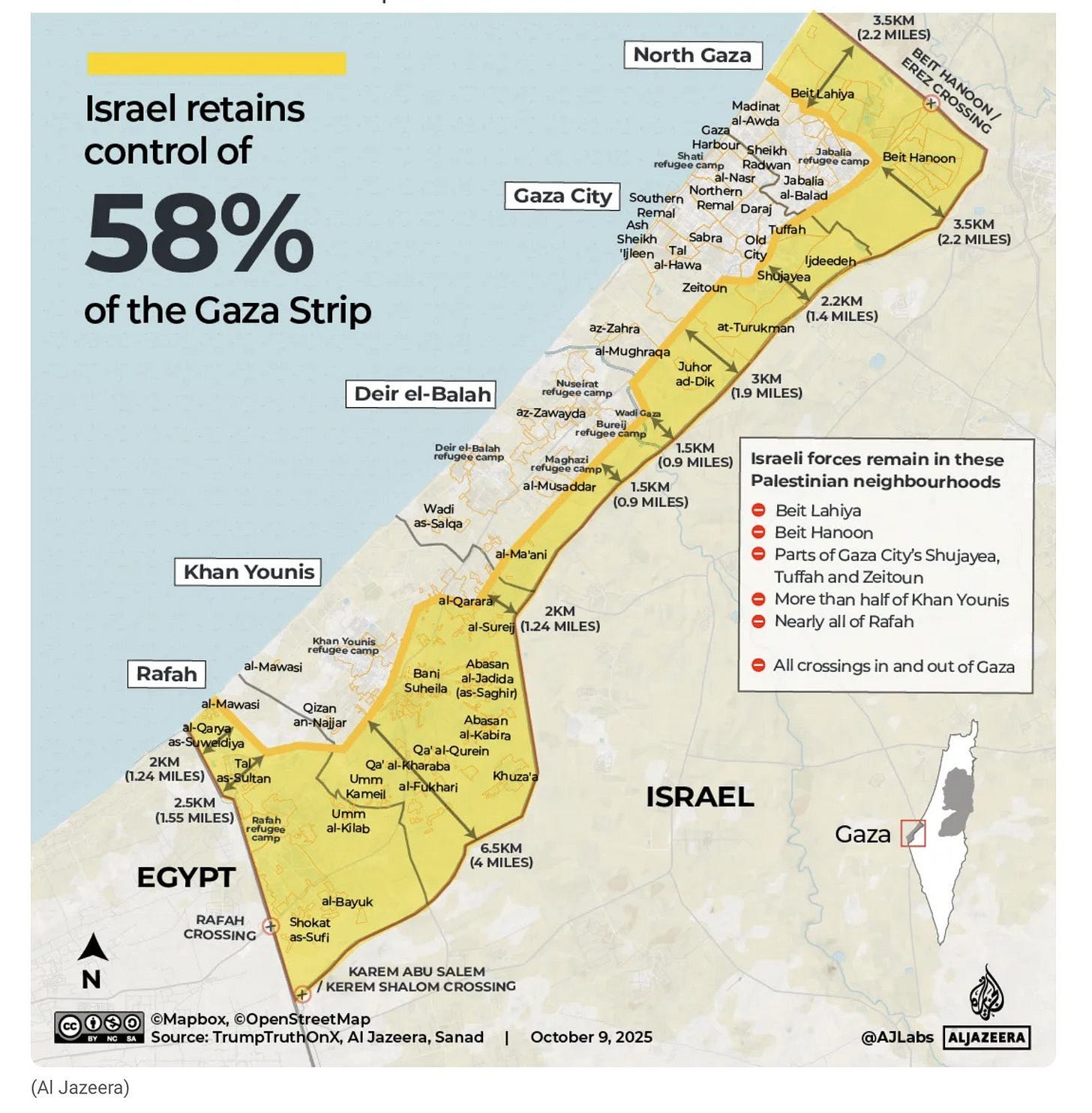No Jews, No News in Gaza
Liberating Arabs was never really the point of all that outrage
The people who demanded peace in Gaza the loudest were the least thankful for the present peace agreement and the return of all living hostages. Professional angry little girl Greta Thunberg, Free Palestine activists on American campuses, and unfunny late night television hosts did not appreciate peace through superior firepower. Truth be told, they preferred the state of war that existed in Gaza before last week. They intuit now that HAMAS is in a far weaker position than before, and that further concerted IDF action might crush them out forever, since there are no hostages left to inhibit that action.
Renewed conflict seems inevitable. Determined to maintain their position in Gaza, HAMAS started recalling fighters to the streets, executing everyone suspected of collaborating with Israel, and intimidating their enemies among the population with exemplary shows of brutality. HAMAS then said they have no more remains of dead hostages available to repatriate. (They have since found another set of remains.) There is no sign of them giving up power in Gaza as agreed. At some ‘phase’ in this peace plan, an impasse will likely result in renewed fighting, and this time the IDF will hold nothing back, because the American president will not hold Benjamin Netanyahu back.
‘Peace’ was not supposed to look like this. Free Palestine did not want the kind of peace that comes with White House pressure on HAMAS. A Palestine that is free of armed terrorists is not at all the peace that the western intellectuals and activists wanted. Peace was not supposed to be a consequence of superior IDF effectiveness at war. The ‘peace’ that Free Palestine wanted was supposed to follow Israeli surrender, not Israeli victory. Israel was supposed to be punished for the purported genocide of Gaza. Gazans were supposed to be executing Jews right now instead of each other: this is the peace that ‘Free Palestine’ earnestly wanted.
Prior disappointments led to caution among analysts. “The fate of this ceasefire will ultimately depend not on American pressure or international boards, but on whether key regional actors — particularly Egypt, Qatar, and Saudi Arabia — choose to maintain pressure on both sides, and whether Iran’s regional posture shifts in response”, Leon Hadar wrote at The National Interest last week. Hadar is particularly interested in what everyone means when they use happy words about the process of getting to peace, since peace in the Middle East is always an interminable process, always a verb and never a noun.
What does disarmament mean? Complete destruction of all weapons, or acceptance of a limited defensive force? What does Israeli security compliance mean? How much territory must Israeli forces vacate? What restrictions apply to Israeli military operations in the remaining zones? These must be negotiated explicitly, not left vague.
International mediation cannot deliver permanent peace, Hadar opined, and he was right, because HAMAS received no international pressure to stop slaughtering the Palestinians they still intend to rule, no outrage from their regional sponsors or their useful idiots in the West. Everyone who does not want to join HAMAS, but is cursed to share Gaza with them, begged in vain for world attention to their plight. But HAMAS was not about give up their power. They were not giving up on violence.
Israel had not collapsed like Yahya Sinwar believed would happen, like the ‘anti-Zionists’ hoped would happen. “Do earnest progressives really think that if the Jewish state were to vanish tomorrow, to be replaced by some utopian binational state, the anti-Jewish furies in the Middle East, Europe or North America would somehow abate?” Bret Stephens asked in a New York Times op-ed. “Or would those furies simply find easier targets?” The answer is that the revisionists always want Jews to be easier targets and wish ardently that Israel did not exist. Sinwar thought he could destroy a fractured Israeli state and got crushed by a united Israel instead.
The oldest diplomatic difficulty for regional states has been recognition of Israel’s very right to exist at all because Israeli military and security forces — the instruments of the Israeli state — prevent or limit the wholesale slaughter of Jews through effective violence. Netanyahu was not allowed to attend multilateral peace talks in Egypt last week because Recep Tayyip Erdoğan did not want to countenance the man who has protected millions of Jews from him.
Still, Trump spoke to the Knesset, flattered the Israelis, signed the ceasefire with everyone, and declared a new day was at hand. Then on Sunday, “two soldiers were killed and three were wounded in an attack by Palestinian terror operatives in Rafah during the morning hours”, resulting in “a wave of intense attacks on Hamas in response”. At the time of this writing, things seem calm again. Who even knows if the ceasefire will be broken again by this afternoon. History suggests that it will not be the last outbreak of fighting in Gaza.
But history does not interest the strategist, and the current strategists planning the new peace use “the intensely personal techniques of real estate deal makers” to bring parties together, in the words of Leslie Stahl. Steve Witkoff earnestly believes in the power of good intentions and fair dealing. In the text of the agreement, “we had to write all these complex words to deal with the fifty years of stupid word games that everyone in that region is so used to playing,” Witkoff told 60 Minutes. History is an impediment to deal-making, for Team Trump.
“Hamas right now is doing exactly what you would expect a terrorist organization to do, which is to try to reconstitute and take back their positions”, Trump’s son-in-law Jared Kushner told Stahl. “The success or failure of this will be if Israel and this international mechanism is able to create a viable alternative. If they are successful, Hamas will fail, and Gaza will not be a threat to Israel in the future.” It sounds so simple in concept, but of course the devil is in the details.
It is an axiom of military history that barring intervention, a siege will continue until the besieged garrison runs out of food. HAMAS is now besieged inside the IDF occupation zone. Israel controls access into the area HAMAS controls. Food, fuel, water, and most importantly for our purposes, construction materials will be available in the yellow zone. If we froze Gaza in this form for a decade, the yellow area would be rebuilt and operate under a civil administration, according to the new peace plan, whereas the HAMAS-controlled 42 percent of the Gaza Strip would remain a disaster area. Israeli forces have already split the strip into smaller sections so they can destroy tunnels and HAMAS units in detail. If HAMAS was to arrange another 7 October pogrom, they would have to do it inside of Gaza.
Obviously, HAMAS will want to disrupt life inside the yellow zone as much as possible while tightening their control of the area remaining under their control. What seems a tidy gerrymander on the map, a kind of political division, is in fact a hybrid warfare zone now, a buffer statelet between the terrorist gang and Israelis. While it will hardly be a ‘safe zone’ for the enemies of HAMAS in Gaza, it will serve to divide the Strip against itself.
The ceasefire “has split Gaza into two alternate realities”, Moumen al-Natour, a lawyer and former political prisoner of HAMAS, says in another New York Times op-ed. “It is impossible for these two Gazas to exist simultaneously for more than a moment in time, and soon enough one will consume the other.” Videos of HAMAS breaking legs and torturing people in the streets are “so intense and so visceral that you would think that their true enemy was Palestinians, not Israelis.” He wants the victors “to force Hamas to abide by the terms of the deal, by handing over its weapons and leaving the future of Gaza to people who have been denied a voice for a generation”. What al-Natour and his colleagues need, that HAMAS will try to deny them, is time and space to succeed at governing that yellow zone.
Even greater than the uncertainty about Gaza’s future is the level of uncertainty about whether a famine took place inside the Strip during the two-year war. For despite the hysterical certainty just weeks ago that mass death was at hand, famine “should by now have resulted in about 9,000 deaths from hunger or hunger-related disease” according to the standardized definition of the word. No such data has been forthcoming because no famine ever existed. HAMAS and the UN could only tally 192 wasting deaths. By way of comparison, there were 23,000 wasting deaths in the United States during 2023, most of them due to malnutrition.
Food prices are down in Gaza markets, which should not be surprising, since over 80 percent of the UN food aid trucks have been stolen since the beginning of May. David Adesnik, vice president of research at the Foundation for Defense of Democracies, criticizes the UN food distribution system for rewarding “the strongest” in Gaza. Violence at UN distribution points has been much higher than the alterative sites set up by Israel and the United States.
Adesnik also addressed concerns about changes in OCHA Humanitarian Situation Reports, which previously described the proportion of aid seekers it claims perished in the vicinity of Gaza Humanitarian Foundation (GHF) distribution sites versus those who died in the vicinity of U.N. aid convoys.
Not long after reports between July 21 and Aug. 18 indicated that more aid seekers perished at U.N. convoy sites (576) than near GHF distribution sites (259), Adesnik said, “we noticed that for the first time, [OCHA] omitted that number of people killed while seeking aid. “ Adesnik said he wonders whether “because the numbers turned against them, they’re just going to stop reporting it.”
Now that GHF is out of money, it remains to be seen just what will replace it in the yellow zone. No doubt a whole new scheme is in the works. “No reconstruction funds will be going into areas that HAMAS still controls,” Kushner said in a press conference. A new security force will be created in the yellow zone, where reconstruction will create jobs, housing, and opportunity. Trump and a “Board of Peace” will decide what to build. Whatever they build, it will ostensibly contrast so strongly with whatever HAMAS is able to build within that remaining 48 percent of the Gaza Strip that Palestinians will see the difference, and choose the development path over terrorism.
Meanwhile, the prisoners Israel released in exchange for the hostages included several terrorists with the Palestinian Authority in the West Bank who will live lives of luxury now as recipients of ‘pay to slay’ incentives that are left over from the Intifada. History has a way of sticking around, no matter what people try to build.
Unleashing capitalism in a Middle Eastern war zone is not a new idea. Whether it is headed by Tony Blair or not, the new yellow zone Gaza entity will inevitably be compared to the Coalition Provisional Authority in Iraq. It will be propagandized as a western colony, the agency of its residents invalidated, their lives forfeit to the jihad, but at least HAMAS will be killing them instead of Israelis.
Economics are driving policy in Israel. Netanyahu needs to wind down the Two Year War and return to peacetime service demands on the national labor pool — something approximating a new normal. In 2005, the IDF withdrew from Gaza, uprooting every last Jewish settler but leaving behind all the built infrastructure. Israelis have no desire to resettle in Gaza now, but they cannot leave HAMAS the whole of Gaza, either, so the yellow zone project is very clearly aimed at containing, reducing, and ultimately eliminating the threat of HAMAS over time.
It is notable that the IDF stranglehold on Iran’s terrorist proxy includes a buffer zone along the Egyptian border, which — also notable — is much more heavily fortified than the Israeli border with Gaza. Those hilarious videos of Free Palestine activists trying to get to Gaza through Egypt, encountering angry crowds of Egyptians rather than the welcoming arms of comrades in solidarity, speak to the deep disconnection between the pacifist dreams of leftist gurus and the decades-long historical reality of Palestinian violence spilling over into neighboring Arab states by way of refugee populations.
Nobody wants the Palestinians, for they remember what happened the last time masses of them arrived, but the population of Gaza must have somewhere to go if they flee HAMAS. The question of population transfer is the most politically-charged, so instead of mass migration to make way for the combat zone, Gaza will be divided against itself. It is a civil war by design — not at all the kind of peace that Free Palestine wanted, but not the war they clearly wanted to continue, either. It will be a turf war between Arabs — a conflict that keeps Israelis out of the news, that creates news about Arabs killing Arabs instead.
The Wild Rumors About Xi Jinping And The CCP Are Just Brand Management
It has been clear for months that something is going on in China. But what? Rumors of change have been rampant. Xi Jinping, President of the People’s Republic of China, was said to have lost power in a bloodless coup; he was under house arrest, and being forced from office this September; a meeting of the politburo in June turned into a struggle session, with a tearful confession from Xi, who had to miss the BRICS summit in July because he is no longer allowed to leave the country. And so on.





If Israel wants to clean house and finish the job, well...who are we to argue?